
HOSTS- Jeremy Burns, Matthew Scott Phillips
TYPE- Ear Training
DURATION- 84:57
BUMPER MUSIC- "Who Wrote The Book Of Wonder"
(Area 47 Music)
ANNOUNCER- Mike Cunliffe
Continuing where episode 43 left off, this episode will review the previously discussed chords:
I, II7, III, IV, V, VI and VII
(in major and minor) and their inversions.
We will now add some secondary dominants:
(V/V, V/II). Listen for the chord qualities (major, minor, dominant 7th, minor 7th and diminished) and use your theory brain to find out how to decipher chord progressions. Use this skill to learn songs faster and know music better!
-This chord is built on scale degree 2.
-In the key of G major, the ii chord is normally a
MINOR chord (Am).
-However, below, we can see that this chord has
been altered (C is now C#). The Am chord,
diatonic to the key, is now an A7 chord.
-This chord now has a DOMINANT (V) function and
wants to resolve to the following chord (also a
DOMINANT chord). So it is considered the V of V.
-This chord is built on scale degree 6.
-In the key of G major, the vi chord is normally a
MINOR chord (Em).
-However, below, we can see that this chord has
been altered (G is now G#). The Em chord,
diatonic to the key, is now an E7 chord.
-This chord now has a DOMINANT (V) function and
wants to resolve to the following chord (the ii
chord). So it is considered the V of ii.


Let's take four listens to identify this chord progression. Below is a good strategy on how to use your listens wisely for each time the progression is played.
1st LISTEN-THE BASS
Use this listen to focus on the bass line. In our first example, we hear the following scale steps in the bass, beginning with scale degree 1 (G):
1 - 2 - 3 - #4 -5 -1
Notate it!
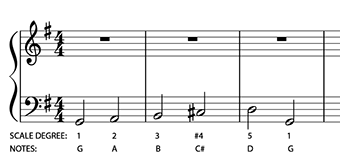
2nd LISTEN-THE HIGHEST NOTE
Use this listen to focus on the melody or the soprano voice. When you hear that note, try to identify what scale degree it is and where it goes from there. Sometimes singing (in your head), from the identified note down to the the tonic, can help zero in on what scale degree it is. In this case, we hear that scale degree 3 begins the following progression in the highest voice:
3 - 2 - 1 - 1 - 7 - 1
Notate it!
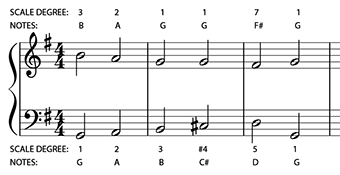
3rd LISTEN-THE THEORY BRAIN
Something harmonic is coming together! We now have enough information to ENGAGE OUR THEORY BRAIN and start making educated guesses at how this progression might develop. Here's an example of the process:
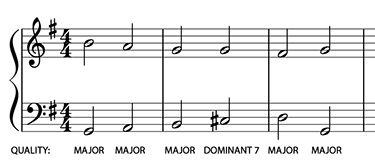
-1st CHORD- Has two notes from the tonic chord (G and B) and sounds like a major chord. The tonic is in the bass as well. Let's call it I.
-2nd CHORD- Has the A note (scale degree 2) in both voices. That doesn't tell our eyes that much. But listen! It doesn't sound like a MINOR chord (normally the ii or vi chord in a MAJOR key). So we can rule out ii and vi. It has a pull toward the following chord and therefore a DOMINANT function. Let's call it V and see what it resolves to.
-3rd CHORD- Has two notes from the tonic chord (G and B) and sounds like a major chord.
Let's call it I. Because the 3rd was in the BASS, we will call it a I chord in 1st inversion (I6). This also confirms the function of the previous chord.
-4th CHORD- Includes the G note (tonic) and C# (foreign from the G major scale). Something funny is happening. This also sounds like a DOMINANT 7 chord but neither of these notes are in the D7 chord (D F# A C). We know it is a V of something. Let's see where it goes.
-5th CHORD- Has two notes from the DOMINANT chord (D and F#) and sounds like a major chord. The 5th is in the bass. Let's call it V. This confirms the previous chords function to be V/V.
-6th CHORD- Has two notes from the tonic chord and sounds like a major chord. The tonic is in the bass as well. Let's call it I. This also confirms the previous chord to be a V.
4th LISTEN-CONFIRMATION
Ideally, this listen will be your confirmation listen. Check out all the voices you filled in and make sure they make sense with what you're hearing.
Here's what it will look like.
WE HAVE FILLED OUT THE MIDDLE VOICES BUT WOULDN'T REQUIRE YOU TO DO SO AS WE CONTINUE TO ADD MORE AND MORE CHROMATICISM
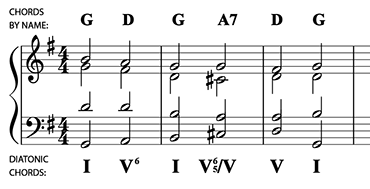
NOW LISTEN AS WE APPLY THIS APPROACH TO THE NEXT EXAMPLES
-When trying to determine which scale degree is in the highest voice, try singing down the scale from that note. If you feel you've reached the TONIC on the 3rd note down, that note is the 3rd. If you can keep going, perhaps not.
-Try practicing progressions using these chords, using CHORALE or KEYBOARD styles.
-Don't neglect the MINOR keys while working on these progressions.
-Try to get good at singing "in your head" or to your self. When you hear a chord, try to arpeggiate the notes in your head.
-Try to get good at identifying the bass lines when listening to music. These will be the first that you will want to identify when taking your listening exams.
-Budget your listens wisely. First identify the lowest notes. Second, identify the highest notes. Use the third listen to engage your theory brain and then the fourth to confirm.
